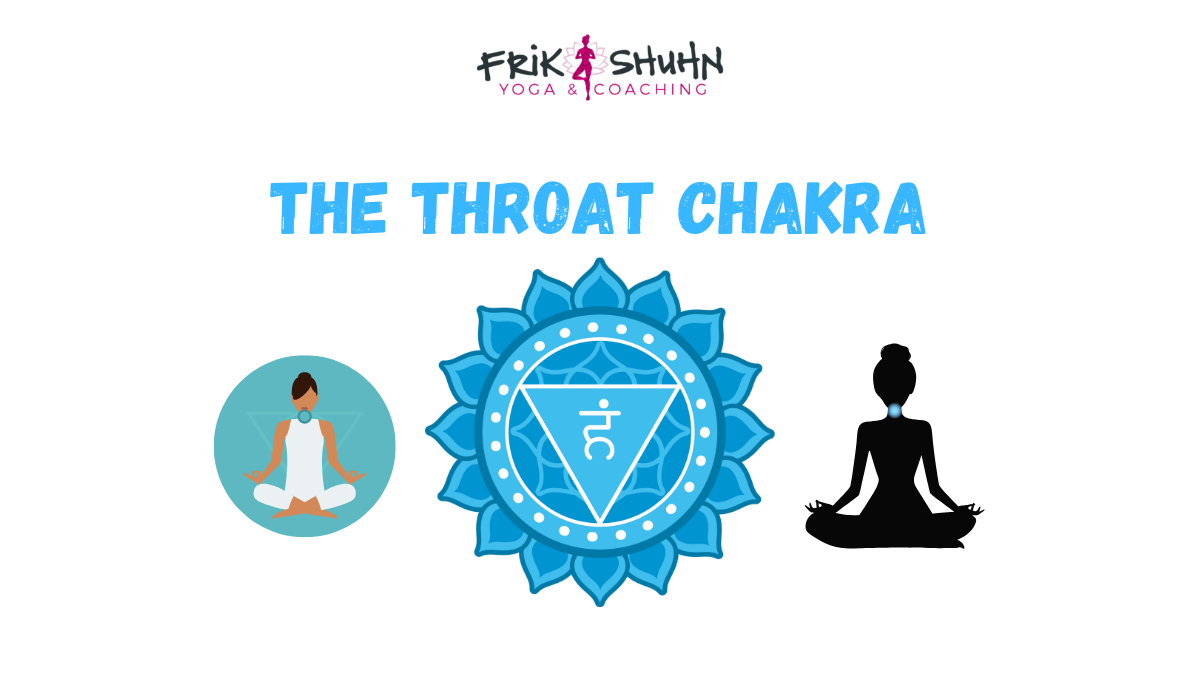Throat Chakra: Expression, Authenticity & Nervous System Integrity

Discover the throat chakra as authentic expression. Explore yoga, breath, and sound practices that heal the voice and calm the nervous system.
🔵 Throat Chakra: Expression, Authenticity & Nervous System Integrity
How many times have you held back your words, even when your whole body wanted to speak? Or felt a lump in your throat when you were about to share something vulnerable? The Throat Chakra (Vishuddha) is at play in these moments.
The throat chakra is the energetic center of truth, communication, and self-expression. Located at the base of the throat, it governs our ability to speak honestly, listen deeply, and express ourselves authentically. In yogic philosophy, Vishuddha is the gateway between the heart (feeling) and the mind (thinking).
In modern science, this region corresponds to the thyroid gland, vocal cords, cervical spine, and vagus nerve — all vital for metabolism, voice, and nervous system regulation.
When the throat chakra is balanced, we communicate clearly, we trust our voice, and we listen well. When imbalanced, we might experience sore throats, thyroid issues, jaw tension, or patterns of silence and inauthentic speech.
This blog explores how Vishuddha links yoga and biology, how somatic practices restore authentic voice, and how teaching from this chakra transforms connection.
Yoga Meets Science: Vishuddha as Purification
The Sanskrit word Vishuddha means “to purify.” Yogic texts describe it as the center where we filter truth from illusion, expressing only what is clear and authentic.
Science highlights several biological systems here:
-
Thyroid Gland: Regulates metabolism, growth, and energy balance.
-
Vocal Folds: Vibrations that create voice and expression.
-
Vagus Nerve Pathways: Running through the throat, they regulate speech, swallowing, and parasympathetic activation.
When we chant, hum, or even sigh, we stimulate the vagus nerve, calming the nervous system and toning our voice. This is why vocal practices feel both expressive and soothing.
Vishuddha, then, is about purifying not only what we say, but also how our nervous system expresses safety and regulation through sound.
The Somatic Lens: The Voice in the Body
Somatically, the throat chakra is deeply tied to how safe we feel to express ourselves. Signs of imbalance include:
-
Jaw clenching or teeth grinding
-
Chronic sore throats or tight neck muscles
-
Holding breath when anxious
-
Difficulty speaking up or feeling silenced
When Vishuddha is balanced, the voice feels steady, the jaw relaxed, and the breath connected. Expression flows naturally, without force.
The key somatic question becomes: What does it feel like to express authentically? Where do I tighten when I hold back? What softens when I allow my voice?
Practices & Examples: Freeing the Throat
Here are ways to support the throat chakra through yoga and somatics:
Asana
-
Shoulderstand (Salamba Sarvangasana): Stimulates thyroid, opens throat region.
-
Fish Pose (Matsyasana): Counterpose that expands chest and throat.
-
Lion’s Pose (Simhasana): Releases jaw tension and activates vocal cords.
-
Neck Stretches: Gentle somatic release for throat and shoulders.
Breath & Sound
-
Ujjayi Breath: Audible breath that tones throat and calms the mind.
-
Chanting or Humming: Stimulates vagus nerve and thyroid function.
-
Lion’s Breath: Inhale deeply, exhale with tongue out and roar.
Somatic Practices
-
Jaw Massage: Gentle touch to release stored tension.
-
Sound Exploration: Explore making sounds without words, noticing sensations in throat and chest.
Journaling Prompts
-
“Where am I not speaking my truth?”
-
“What happens in my body when I silence myself?”
-
“How can I honor both speaking and listening?”
Transformation & Teaching
For yoga teachers, Vishuddha is both literal and symbolic. Literally, it’s your voice guiding the class. Symbolically, it’s your authenticity as a leader.
When you embody throat chakra balance, your teaching becomes clearer and more resonant. Students feel not just the words but the integrity behind them.
You might cue: “As you breathe, notice the vibration in your throat. This vibration is your unique expression.” Or invite humming at the end of class to let students experience the calming effect of sound.
When students explore their own voices, they reclaim authenticity. When teachers model this, they create a culture of truth and trust.
Why Throat Work Matters Now
We live in a noisy world, where many voices speak but few feel heard. At the same time, many of us silence ourselves out of fear, shame, or habit. Working with Vishuddha is about finding the middle path: speaking with clarity and listening with openness.
Science shows that sound practices regulate the nervous system, improve mood, and foster resilience. Yoga reminds us that voice is not just communication — it’s vibration, resonance, and connection.
By integrating both, we learn that voice is healing. Expression is medicine.
If you want to explore Vishuddha and the other chakras more deeply, here are three ways forward:
✨ Access the Awakening the Chakras YTT online inside my Experiential Teacher Path subscription. For $297/month, you’ll get this training plus every other YTT I offer, counting toward your 300-hour certification: Join Here
✨ Download my Free Chakra PDF to explore the chakras with science-based insights and practical tools: Get the PDF
✨ Join me at the 50-Hour Chakra Teacher Training at Anamaya in Costa Rica. Experience Vishuddha through embodied practices in a transformational retreat setting: Learn More Here
Final Reflection
The Throat Chakra is more than just voice. It’s the integrity between inner truth and outer expression. It’s how your nervous system communicates safety, and how your body resonates with authenticity.
Yoga says Vishuddha is purification. Science shows that voice regulates the vagus nerve and calms the mind. Together, they remind us that truth isn’t just spoken — it’s embodied.
When we free the throat, we free ourselves to live authentically. And when we teach from this place, our voice becomes more than instruction — it becomes inspiration.
 Colynn Vosburgh
Colynn Vosburgh 